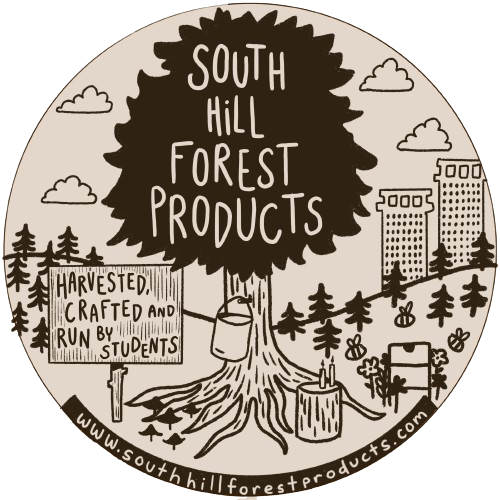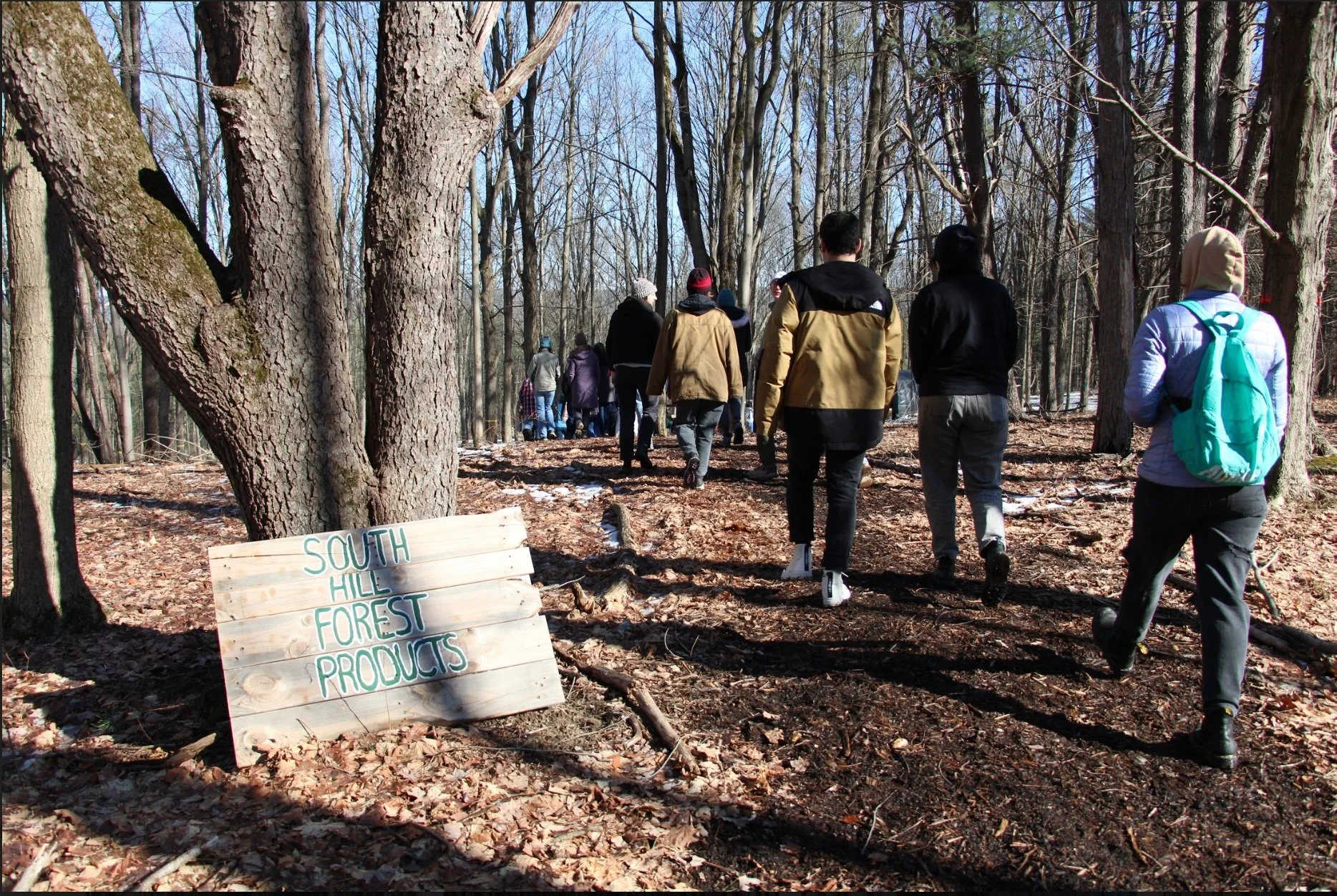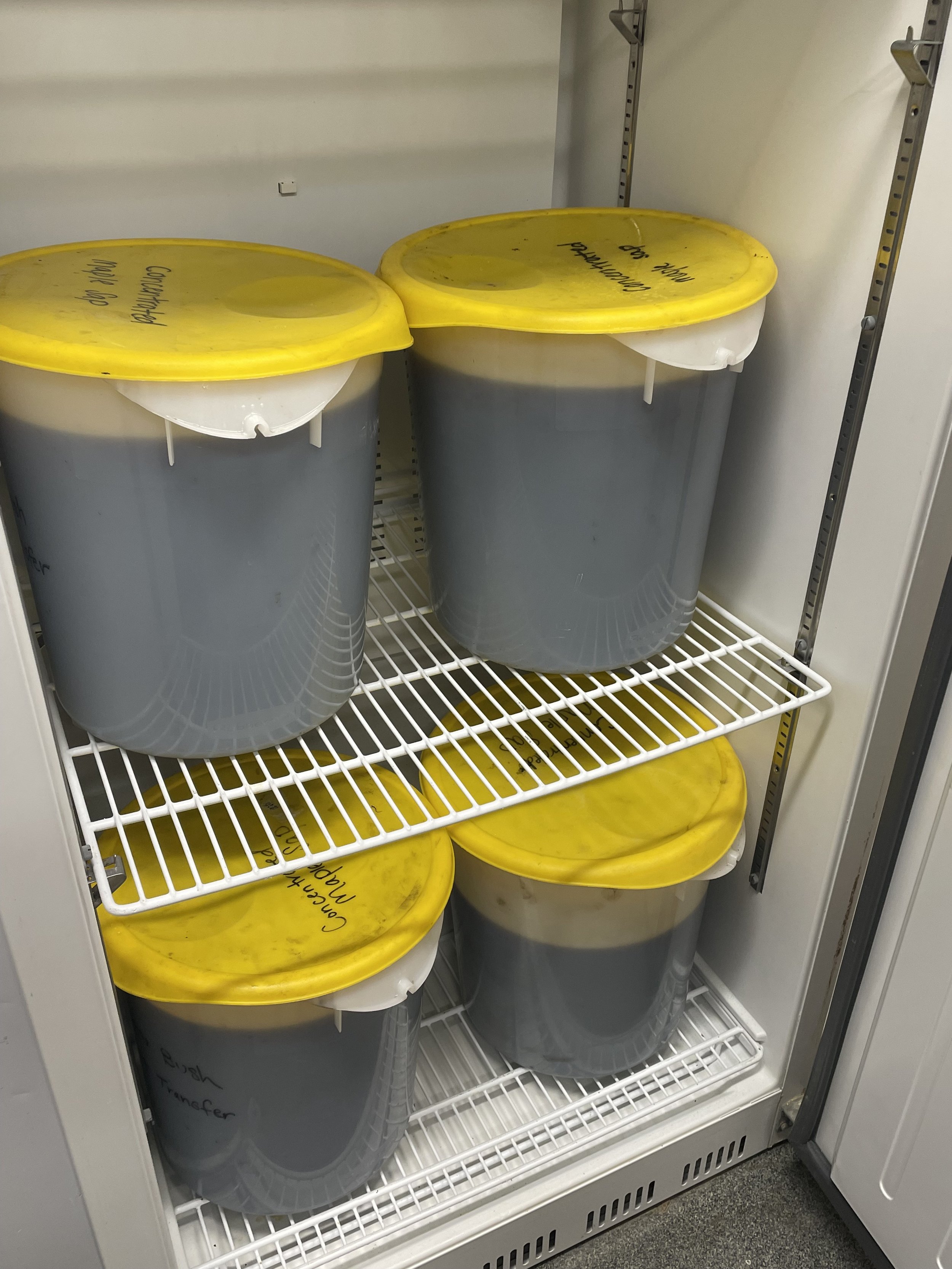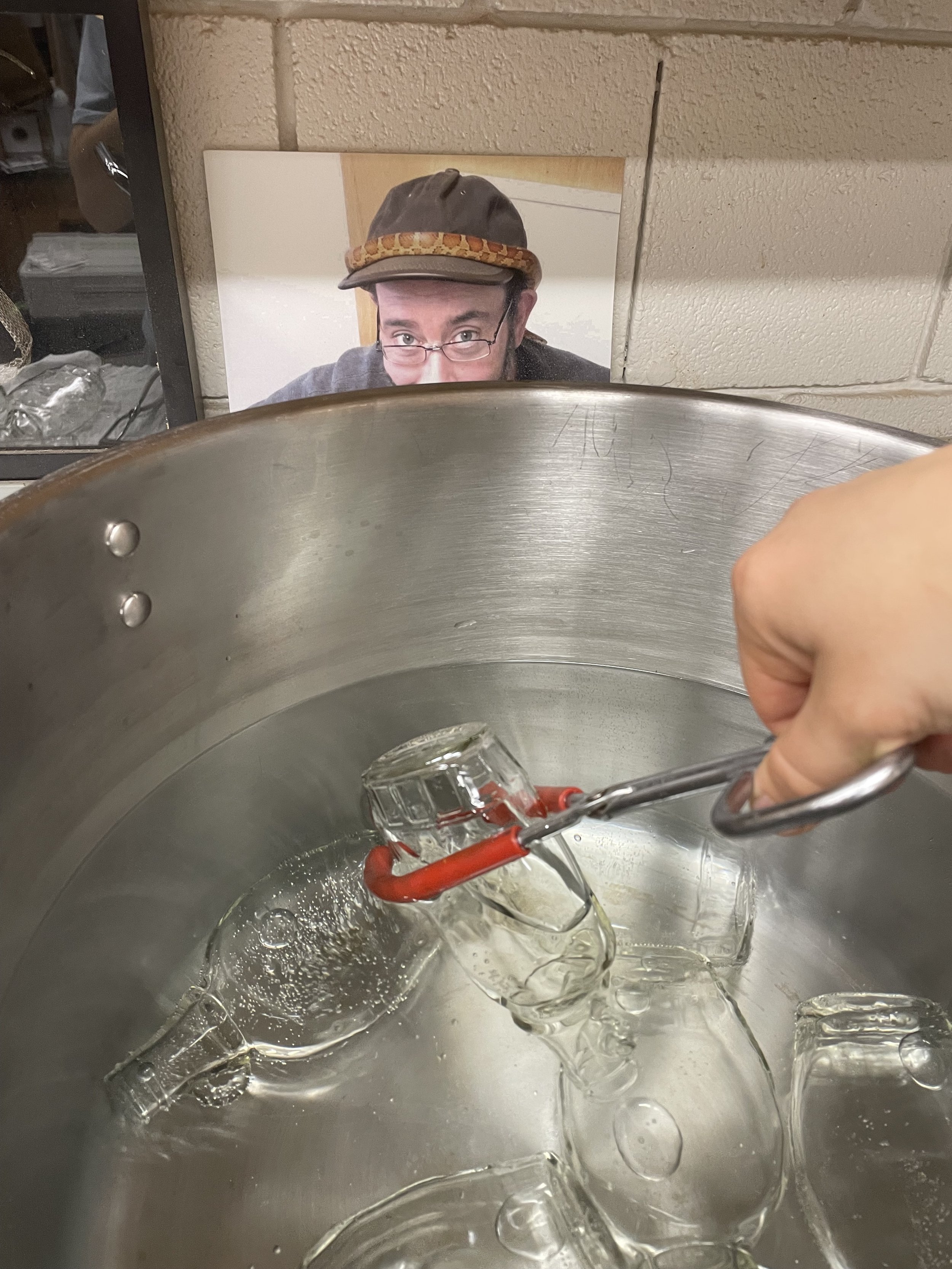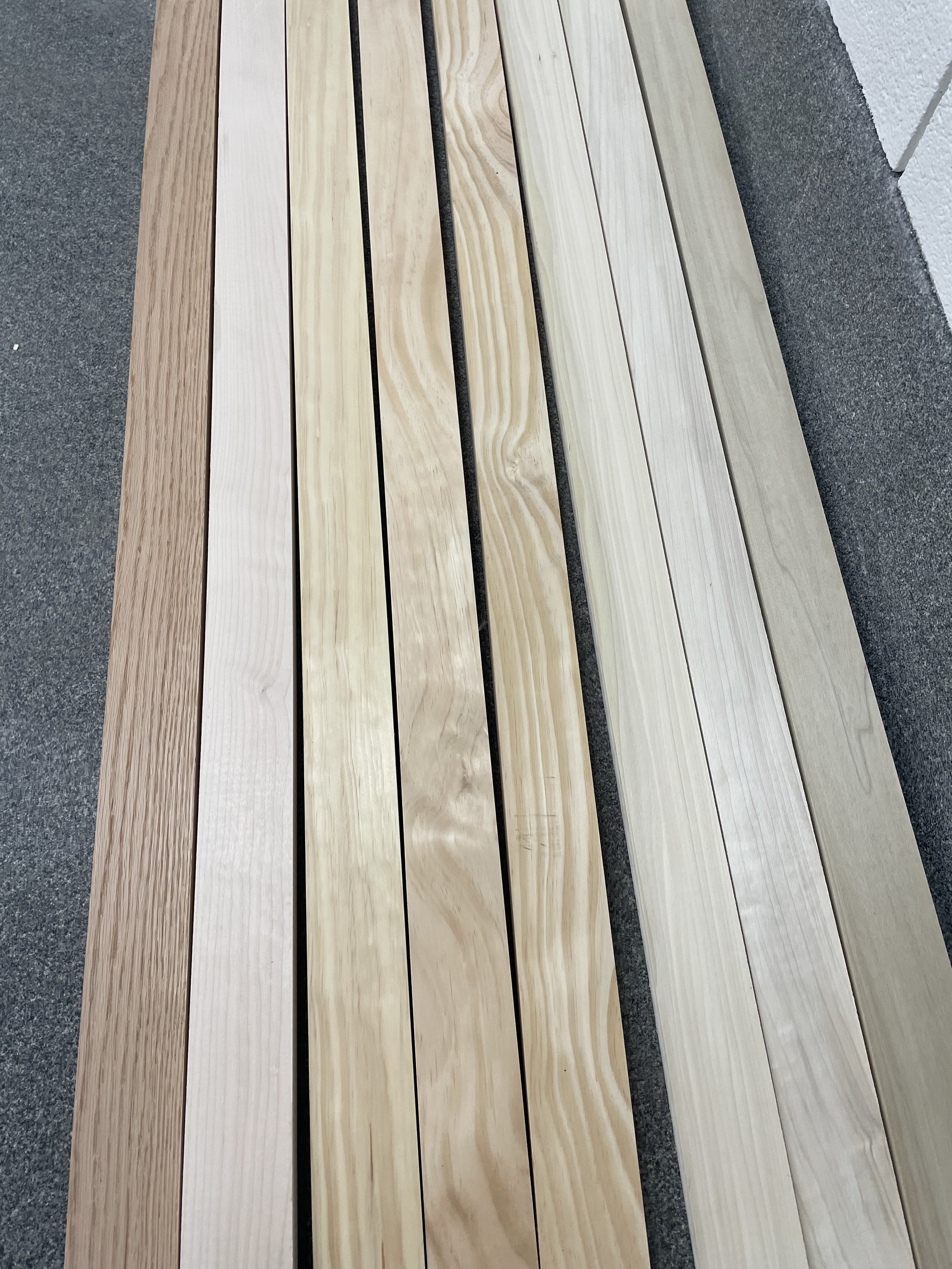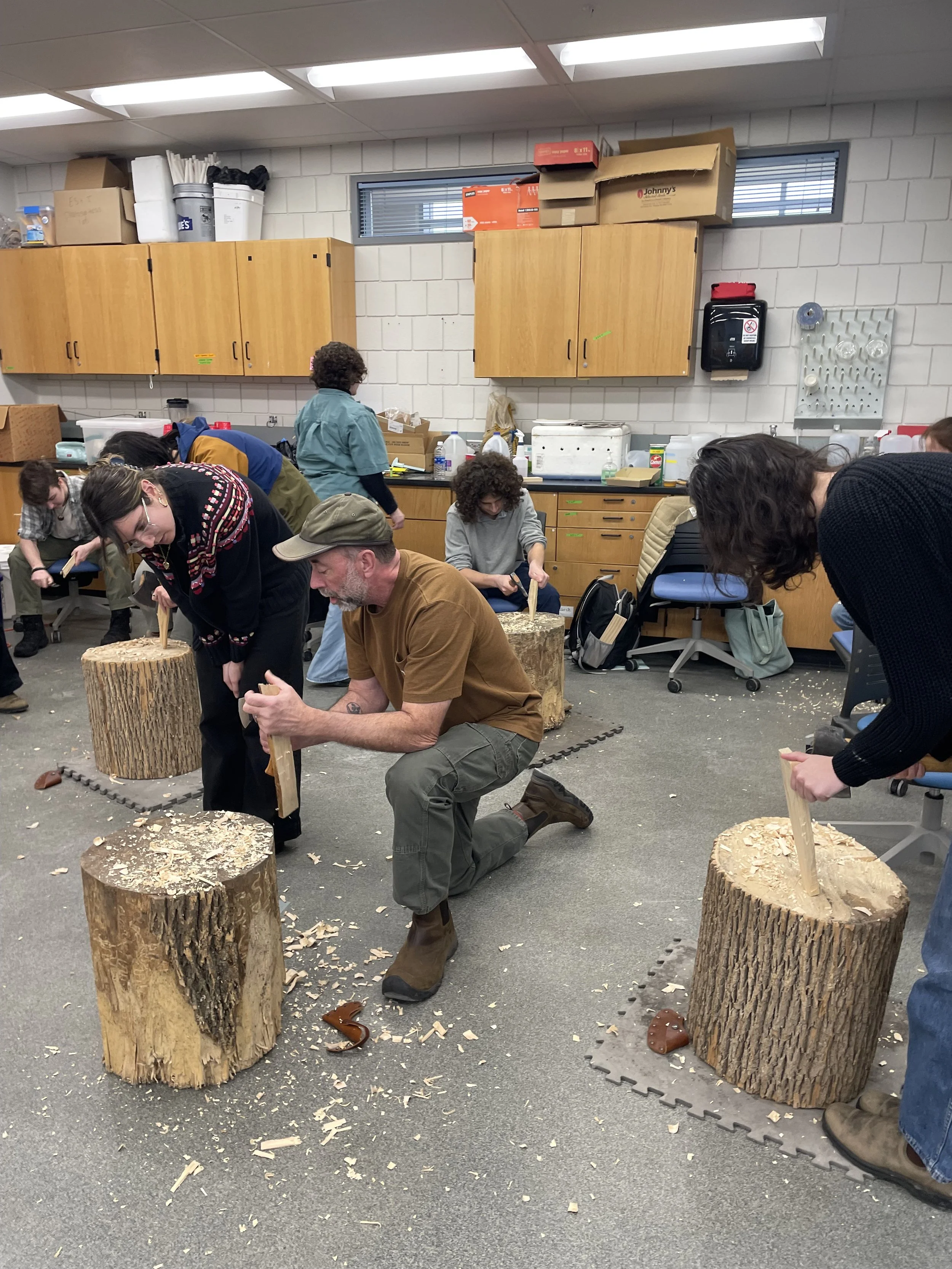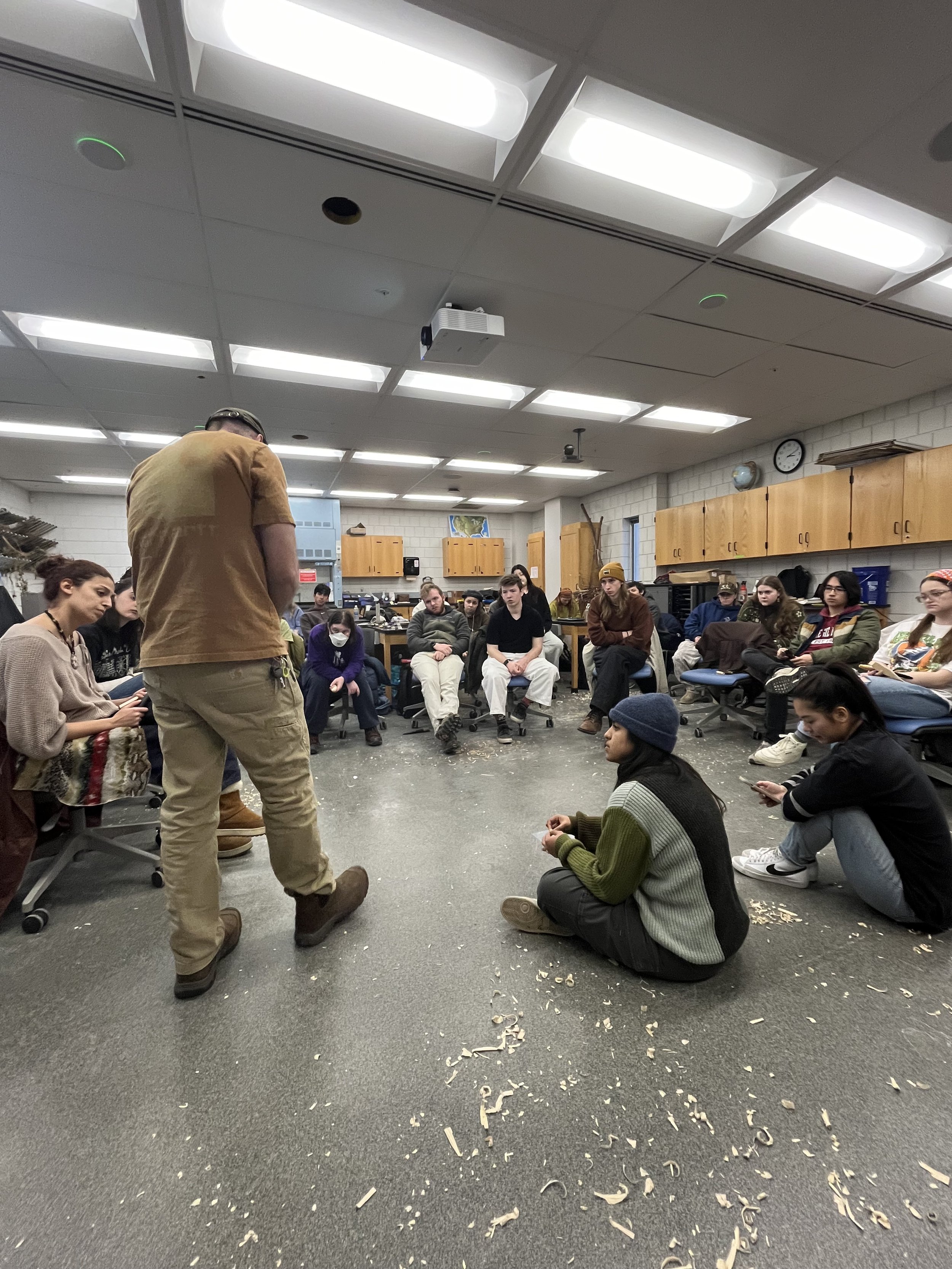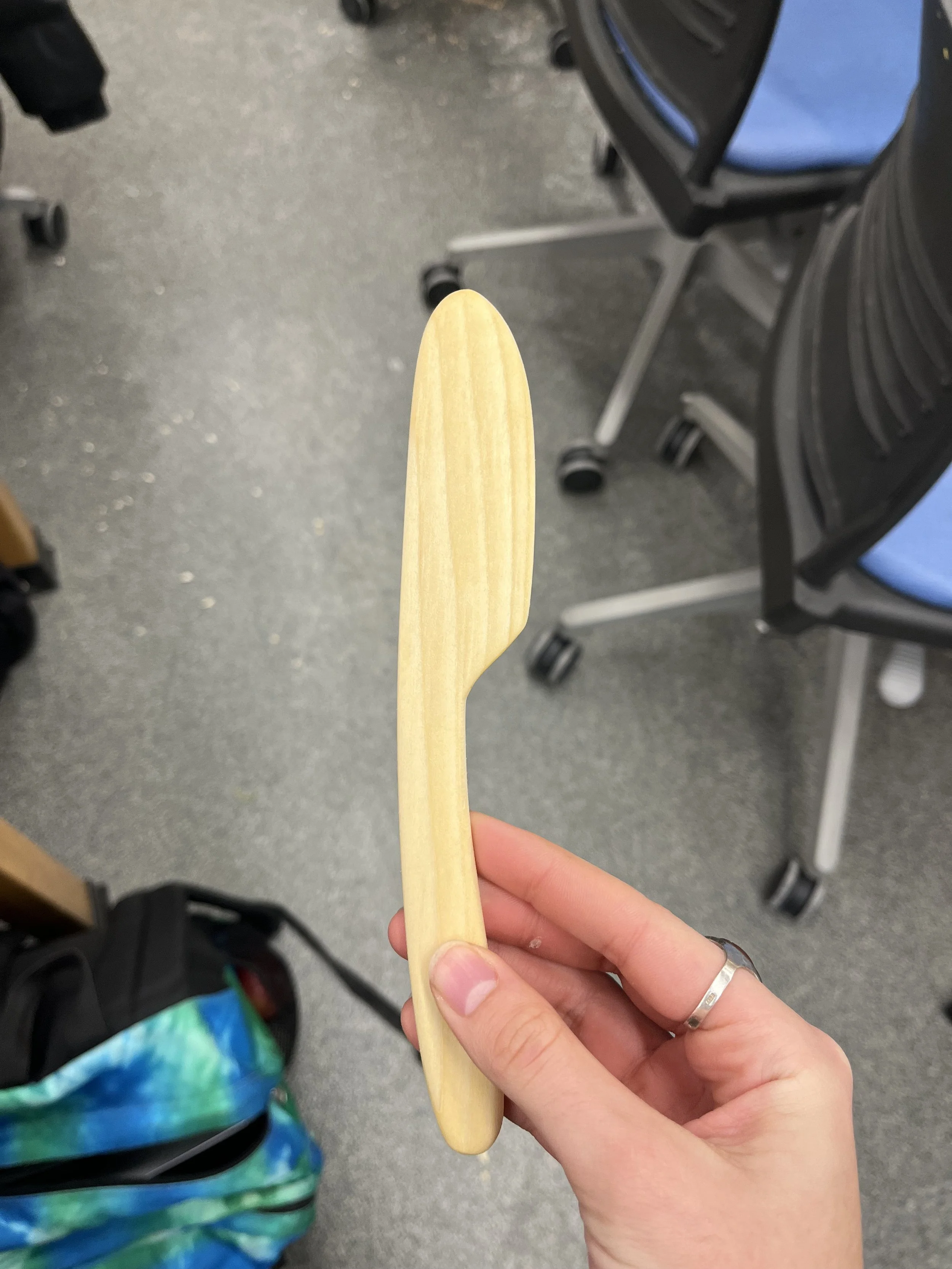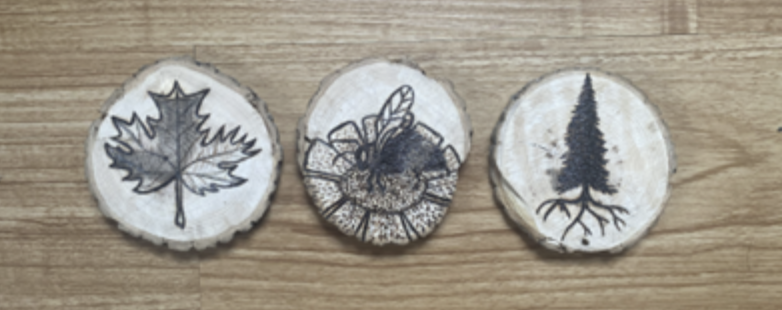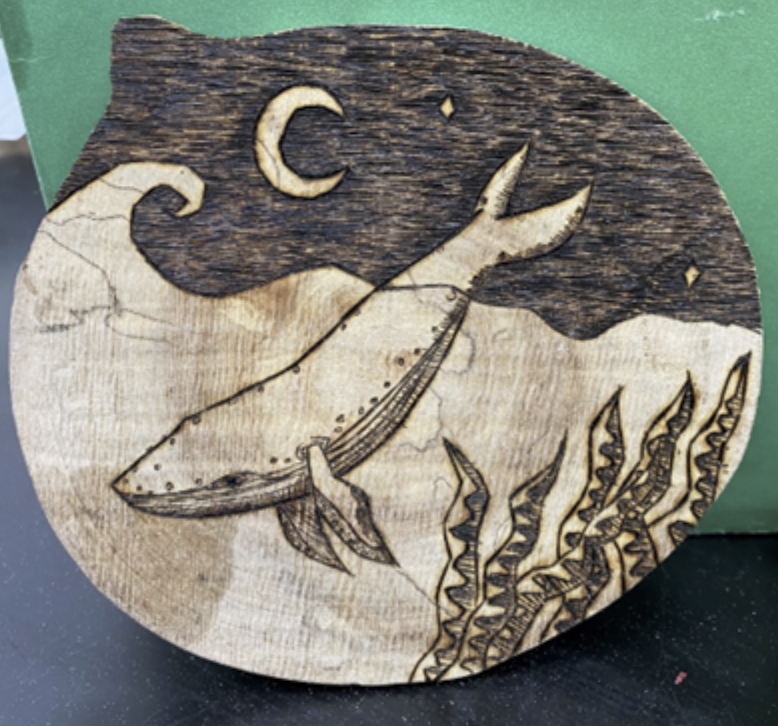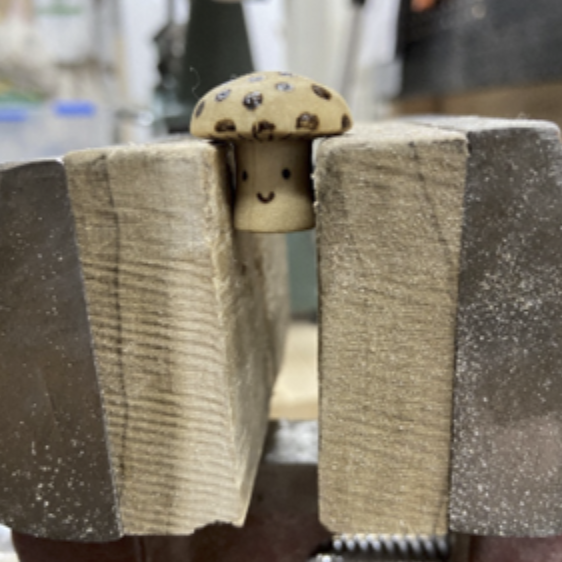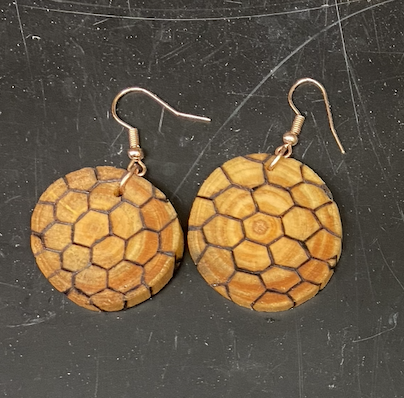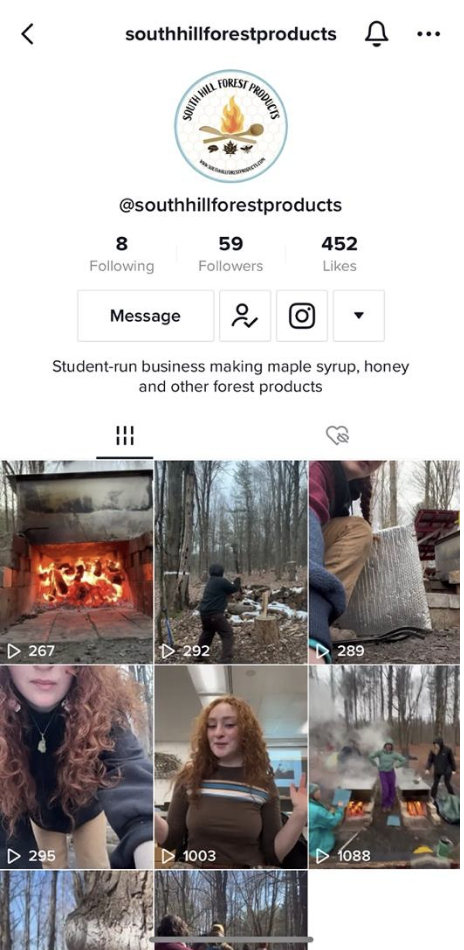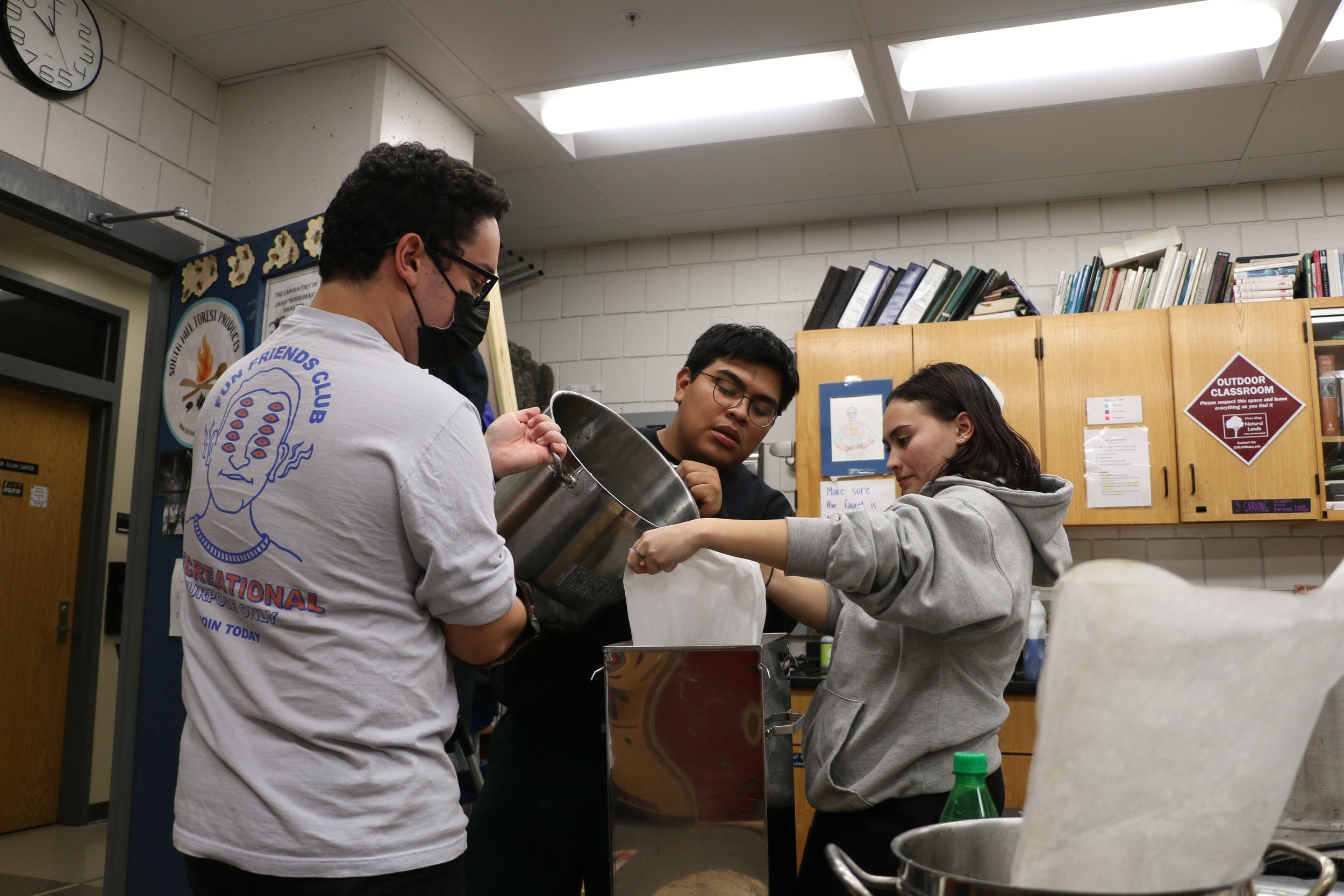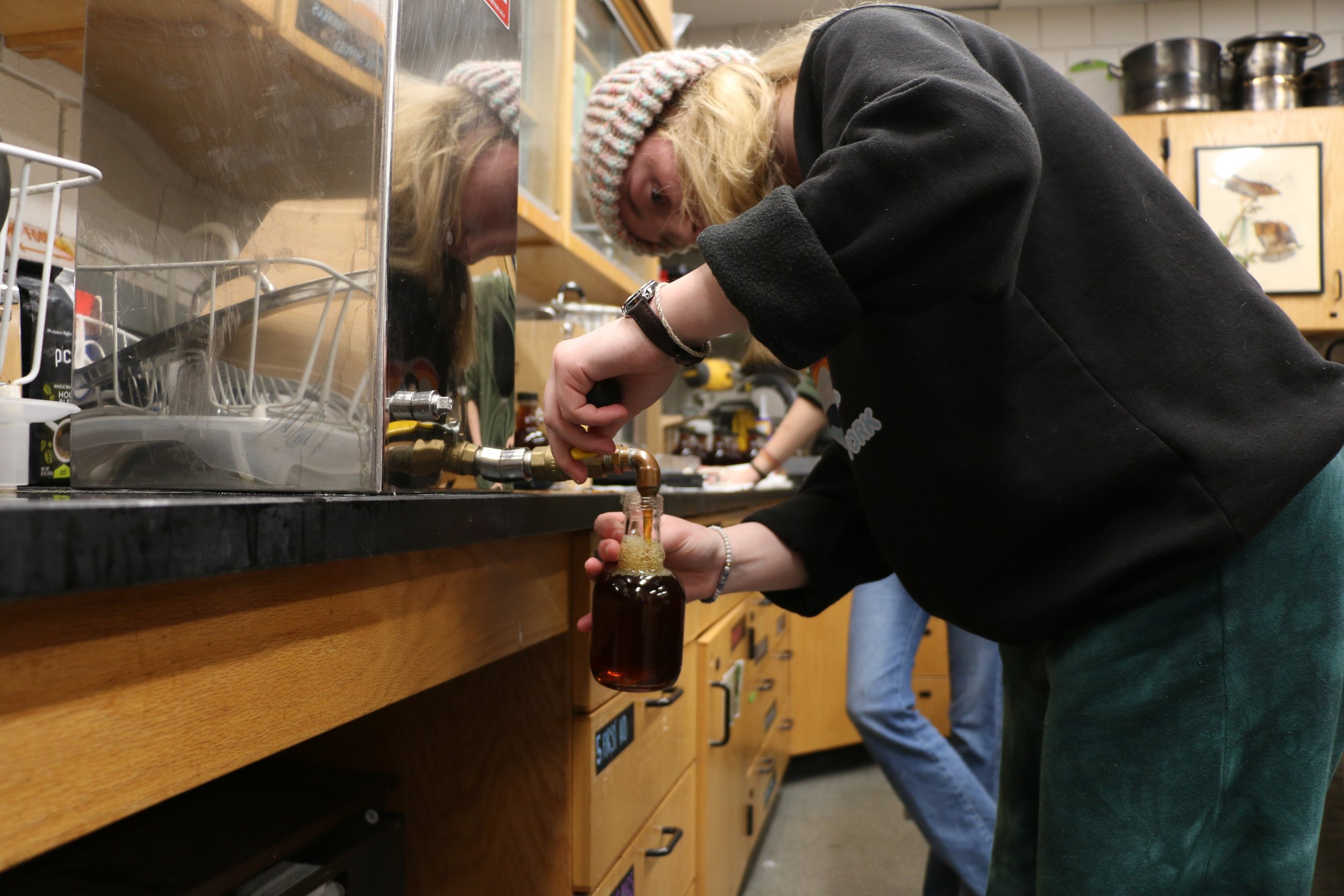South Hill Forest Products Blog
Open House ‘25
On April 26, 2025, South Hill Forest Products hosted its annual open house! This is an even hosted annually to celebrate the maple syrup season with pancakes, activities, games, and shopping. The open house also serves to bring the community closer to the forest, answering any questions about our business, syrup, or other products! And who doesn’t like pancakes with delicious maple syrup?!
The whole business worked tirelessly for the past month finishing numerous products like beeswax candles, wooden mushrooms, wooden candle holders, bark baskets, bottle openers, key hangers and so much more.
As we are closing for the season, this year’s students are preparing for new products to possibly be sold some time in the future (some to come next year!). These projects include birch bark baskets, balms, and pine pitch.
Thank you to everyone who came to the event! This was an event that we students in the class will remember forever. We hope to see you again next year!
Indoor Boil
To get the most precise sugar content in our syrup, we finish the boil inside. We took the concentrated sap, filtered it, and continued oiling it in pots in Jason’s lab. We continuously took the brix measurement with the refractometer to get the magic number of 67, when we would then take the syrup off the heat. While some people were stirring the pots, measuring, and filtering, another person on shift would be sanitizing the bottles and then bottling the finished product once it’s ready. We finished with 172 bottles of syrup from the first boil!
Outdoor Boil
The fires are burning and the sap is flowing, this can only mean one thing… it's maple syrup season! It takes a lot of work to get from tree sap to delicious syrup. We collect our own sap to boil our syrup. At South Hill Forest Products, we want to tap maple trees that are healthy so our trees can continue giving sap throughout the years. Additionally, we use a wood fire to boil down the syrup, keeping the sap boiling for a total of 71.5 hours!
Wednesday the 19th, we started to boil our collected sap (around 680 gallons) into syrup! It is a very long and tedious process, but very rewarding. In the woods, we set up our boilers, fire burning hot to get the sap to boil. As the fire continues to evaporate the water, more sap is added. Meanwhile, we filtered and added sap, skimmed the surface, chopped wood, and fanned the fire to make it extra hot. We boiled until the sap reached a certain sugar content, where we will boil the sap a little further indoors to make sure our syrup is extra delicious! Boiling was exhausting, yet rewarding for everyone who can’t wait to share the extra delicious syrup.
Axe Carving
The past couple of weeks we’ve been learning all about axes - carving with them, chopping wood with them, and appreciating how they are the product of hundreds of years of human ingenuity and innovation modifying this technology to be the most effective it can be for specified or general purposes. We were able to see many of Jason’s axes and use some of them to chop wood out in the sugarbush and carve during class and in his lab. Many students find axe carving more fun than knife carving since you can waste a lot of material much more quickly. We’ve been using axes to start carving butter knives, spoons, and spatulas, and then put the finishing touches on with a knife. In our recent class, Jason brought in some boards that were different types of wood, and we learned about the different aspects of wood of different tree species, like Janka hardness. We examined the boards and got to see and feel the differences between oak, maple, poplar, and pine!
Daily sap checks!
At least once a day, a group of 3+ go out to check on each bin, collect the sap and consolidate it into barrels to be stored until the boil!
First Day at the Sugarbush
This Wednesday, since the weather was consistent for optimal sap flow, we tapped 105 trees! The class split up into teams of four, drilling holes into maple trees, attaching taps and tubing, then feeding this tubing into buckets and covering them to protect collected sap from animals and falling debris. We will be checking sap levels every day from now until the end of maple syrup season, likely sometime in April. We care deeply for the health of our trees, so we took the utmost care in choosing where to drill holes for our new taps, ensuring the least amount of damage to the trees as possible to keep them happy and healthy, providing us with sap for many, many years to come!
Tap and craft
In a matter of less than two weeks, the SHFP crew banded together to create products for Tap and Craft, an event at Hotel Ithaca that features breweries, cideries, and distilleries from the Finger Lakes and beyond, as well as vendors of items such as mugs, soaps, and jewelry. We knew this would be a unique opportunity to showcase our business, but we were on a time crunch. We wanted to create some items to go with the Tap and Craft theme and decided to make and sell bottle openers, flight boards, and coasters. The only slight issue was we had never made flight boards or bottle openers before. Thanks to the hard work of Jason and the students, though, we were able to prototype these new items and have 20 bottle openers and 5 flight boards ready to sell at the event. Also on sale, we had coasters, ornaments, earrings, butter knives, and honey. Attendees were excited and impressed to learn that we’re a student-run business and everything is handmade, so in addition to selling hundreds of dollars worth of products, we also got the word out about how cool South Hill Forest Products is, so all in all, it was a success!
Coasters!
Here are the first wood-burned creations ready for sale at Tap and Craft: Saturday Feb. 15th at Hotel Ithaca
Introducing The SHFP ‘25 Crew
We’re back! After a one year hiatus due to our CFO being on sabbatical, we’re more pumped than ever to get SHFP back online - check out our updated Meet the Team page and our Instagram @southhillforestproducts to see this year’s crew! In the past few weeks, we’ve formed teams to take on different aspects of the business like marketing, sales, and social media, as well as teams for different product lines like woodworking and gifts from the bees. We have also been reading up on maple syrup in preparation for the boil, and have been learning to carve wooden utensils and woodburn. Jason taught us carving techniques to maximize safety and efficiency with each cut, and students have since made butter knives and spoons!
2023 Blog:
What Is Hickory Syrup??
A Smokey, Sweet Alternative to Maple Syrup!
The students of Non-Timber Forest Products have been busy this semester! While we’ve been busy collecting sap and boiling it to make maple syrup, some of us have also been working on a different type of syrup called hickory syrup. This product requires a whole different process than maple syrup, but it is just as delicious!
As you can tell from the name, hickory syrup comes from hickory trees. Instead of being made from sap like maple syrup, this syrup is made from tea. To begin the process, we have to collect as much shag bark as we can. Shag bark is the loose pieces of bark on hickory trees that come off easily with a little pressure. After we have enough bark, we take it home with us where we prepare it for the tea. To ensure that the bark is clean, we thoroughly wash it, then we bake it. Once it’s done baking, we boil it in a pot of water to create the hickory tea.
Already, this process is very different from maple syrup. For maple syrup, we boil the sap to reduce it to its syrup state, but for hickory syrup, there is no sap or natural sugar. Instead, after we make the hickory tea, we continue to boil the liquid while we add brown sugar to it. Then, we boil the tea mixed with sugar down until it turns into a syrup.
At the beginning of the month, I worked with two other students to collect, bake, and boil enough hickory bark to make about 80 bottles of syrup. Hickory syrup needs to be made in a commercial kitchen, so we worked in one of Ithaca’s dining hall kitchens for 6 hours to complete the process.
While the job was tiring and long, it definitely paid off. Hickory syrup has this smokey, sweet flavor compared to maple syrup’s sugary sweetness. We also got to experiment with the different batches, and we ended up making two additional flavors of syrup. We made an autumn spice syrup, which is made up of spices like cinnamon and nutmeg. This flavor is popular and has been made in the past. We also made a new flavor this year by adding bourbon to the syrup. This one is going to be popular because of how good it tastes!
If this blog post has you craving some hickory syrup, don’t fret! Come to our pancake open house on April 22nd where you can buy as much syrup as your heart desires. Hopefully we’ll see you there!
Written by Julia DiGeronimo ‘23
Environmental Studies
Other Gifts Team
A Sneak Peek into our Crafty Projects and Other Treats!
The SHFP Other Gifts team has been hard at work creating various pieces for our events, such as the upcoming open house on April 22! Our team encapsulates most of the non-maple syrup and carving projects at South Hill Forest Products. This includes our popular beeswax candles! We make these candles by melting wax in a double-boiler and pouring it into one of our several mold options.
We have also been experimenting with scented candles this year! We are trying both soy-wax candles and a blend of soy-wax and bees-wax for our candles. Look out for the scents of coffee, lavender, and lemon in these adorable thrifted cups!
And that’s right, you spotted it, we are piloting maple sticks this year as well! Taking inspiration from the classic honey stick, we know this one is the perfect little treat. We have also been having lots of fun with various wood burning projects! There is a lot you can do with a wood burner, and we are exploring as much as we can. Some wood-burning projects we have been working on include earrings, coasters, and wall hangings! We have other ideas in the works that are currently top secret…
This year we are developing cutting boards as well! This research project has been quite a lot of fun for the students working on it! Here is a look into the process, as explained by Environmental Studies major Aly Richard:
“What I’ve been doing is working with Jason to use the wood, measure it out, and cut it with the jigsaw. Next, I draw out the shape of the cutting board and Jason helps me to round out the edges and get the right shape! I then use the sander to sand down the cutting boards and then individually sand them with my hands for the small details. Then, I sketch out the design I want for the wood burned portion and then I use the wood burner to solidify the designs. Finally, I use mineral oil to polish off the boards!”
And that’s not all! We are still exploring other crafts for our roster! Coming up, we are learning how to make bark baskets. We are looking forward to sharing our collection of crafts with the community! Get ready, our open house is less than three weeks away! See you there on April 22!
Students bringing the last of our tapping equipment back to the sugar bush as we prepare for the open house!
Written by Arthur Robbins-Geller ‘24
Environmental Studies
Finishing the Outdoor Boil
So Long to the 2023 Maple Season!
On Wednesday, March 22, we officially started our third and final maple boil to finish off our 2023 maple season!
Earlier in the week, students went to remove taps, tubing and buckets from our 104 trees, allowing them to begin healing for next year’s maple season.
We officially started our 3rd outdoor boil at 3:00PM Wednesday and staffed the boil around the clock until Saturday, March 25. At 12:00AM on March 25, we officially stopped adding sap to the boiling pans, thus beginning the end of the boil.
🍁A Timeline for Ending the Outdoor Boil 🍁
11:30PM: Students went to the lab to collect equipment for ending the boil (refractometers, pipettes, and sap transfer barrels with water for the fires). They brought these things with them to their midnight shift at the sugar bush.
12:00AM: After adding the last sap to the boiling pans, students continued to boil the sap, skimming foam and consistently checking brix levels until the sap reached roughly 55-60 brix.
At first it was slow going, as the sap was only at 28 and 30 brix, so students took some time to rest and stargaze around the fire, checking the brix levels of the boiling sap every 15 minutes, then more frequently once brix levels reached 48 - 50. Consistent checking is necessary at this step in the boil to ensure that the sap doesn’t burn or rise to a high brix level unfit for maple syrup (above 68 / 69 brix).
Check out the gorgeous view from the sugar bush!
3:25AM: When the sap in the pans reached 55 brix, it was officially all hands on deck. 2-3 students moved the hot pans off the fires, placing them in the dirt to cool, while 1-2 students poured water on the fires, extinguishing the hot coals.
While the pans of sap cooled, students began to pack up boil equipment and clean up the site. Students carted equipment from the sugar bush out to where their cars were parked on Rich Rd, and began spreading out ashes in previously cleared areas, making sure that all the hot coals were extinguished.
The hot coals look almost like a red galaxy!
When the sap had cooled enough to handle, students tested brix levels one last time, recording final brix at 53 and 58. Students then worked to pour the sap from the pans into the sap transfer buckets, which they used to transport the sap from the sugar bush to the lab.
4:29AM: The outdoor boil was officially finished at 4:29AM on Saturday, March 25, after students had taken all the boil equipment back to the lab, safely storing four buckets of sap in the lab refrigerator for the indoor boil. This made the total time for our 3rd and final boil a whopping 61.5 hours!
On cold nights, the chimneys are perfect for warming up your body / hands!
🍁The Indoor Boil 🍁
Our last indoor boil started on Wednesday, March 29, at 4:00PM and ended around 11:15PM that same day, producing about 9 gallons of syrup. This brings our total produced syrup for the 2023 season up to an all-time class record of 28 gallons! To put that into perspective: the class’s previous record was set in 2016, and was only 18.2 gallons! How exciting is that?!
Interested in purchasing some delicious maple syrup? We are still selling our maple syrup (and soon our hickory syrup) through our online store (www.southhillforestproducts.com/products), so make sure to purchase a bottle before supplies run out!
🍁What’s Next? 🍁
Though the maple season is officially over, there’s still lots for students to do, as well as lots of continued opportunities for learning!
The site-prep team has been working to clean buckets, taps, and tubing in order to store it away for next year. The research and development team is still working on separate crafting projects (such as beeswax wraps, salves, special carvings, cutting boards, and wooden earrings) so that we’ll have lots of fun things to sell at our Open House!
There will be several opportunities for further learning, including band saw / lathe turning certifications, ax carving workshops, and a shiitake mushroom field trip to Hawk Meadow Farms.
Students will continue packing and shipping orders, as well as preparing for the open house on April 22—be sure to come!
Written by Rebecca Rivera ‘23
Professional / Technical Writing
SHFP Social Media
Follow us on Instagram and TikTok!
Hello all! We are the South Hill Forest Products social media team!
For the first half of the semester, we worked on figuring out what social platforms to use to best advertise our products and educate our customers about our student-run business! We held both Zoom and in-person meetings to discuss our target audience and what kind of content we wanted to present on certain platforms.
We decided to focus our attention on the Instagram and TikTok pages, shifting from YouTube to TikTok as we saw that TikTok was a more popular and trendy replacement to get new followers. Our TikTok page (@southhillforestproducts) is full of fun little videos of team members at the sugarbush during boils, question of the day, tree tapping and more! Give us a follow to see more content!
Main page of the SHFP TikTik account!
Our team has been posting on Instagram (@southhillforestproducts) with our main page seen in the picture below. We have posted pictures as well as posting Instagram stories of our sugar bush site, where we tapped our maple trees and then boiled the sap we collected! Please check us out to view our stories and see what is going on over there right now!
Main page of the SHFP Instagram account!
🍁Online Store 🍁
Our website store (www.southhillforestproducts.com/products) officially opened March 22nd and is still currently live, so be sure to order your maple syrup!! We have already sold out of the 1.7 oz bottles, but don’t worry! We still have 8.5 oz bottles priced at $12, and 12 oz bottles priced at $15.
We offer shipping as well as in-person pick up for all SHFP orders. To pick up your order, email us at southhillforestproducts@gmail.com and set up a time to come into room 282 (pictured below) in the Center for Natural Sciences (CNS) building at Ithaca College. More products like hickory syrup will come to the website in the coming weeks!
Our 3rd and last boil of the semester has just ended, officially wrapping up the end of our 2023 maple syrup season with one last indoor boil coming in the next few days, so keep posted for more updates!
🍁Open House 🍁
Our open house will be held on April 22nd from 10am-2pm at the sugar bush off Rich Rd, Ithaca, NY. There will be a shuttle available throughout the event, taking students and visitors from the Park School bus stop at Ithaca College to the sugar bush, so make sure to come get some pancakes with our famous maple syrup!
We will also be selling our other non-timber forest products, such as hickory syrup, butter knife and spoon carvings, lip salves, and research and development projects like wooden cutting boards, maple cookies, maple hard candies, pine needle baskets, earrings, beeswax wraps, recycled paper, and more! What better way to celebrate Earth Day than with us and some delicious food and non-timber products?!
Please stay in touch with us, and if you ever have questions or concerns about anything, don’t be afraid to DM us on Instagram or Tik Tok (@southhillforestproducts) and / or to email us at SouthHillForestProducts@gmail.com! Please follow us if you don’t already and give our posts / videos a like as well as a repost, helping to spread the word on our growing business here in the heart of Ithaca; thank you so much!
Written by Adriana Sulca ‘24
Environmental Science
Carving Management
SHFP Hand-Carved Wooden Goods!
Some of South Hill Forest Products’ staple products are hand-made wood carvings, completed from either pre-cut blanks or found wood.
Carving is a practice that has been around for centuries. Wooden utensils are extremely heat resistant, lightweight, and long-lasting. With proper care and maintenance, wooden spoons can survive generations and many delicious meals. Carving has become a functional way to make utensils as well as being an art form.
Two butter knives carved by the author
During the Farming the Forest class, students have a chance to learn wood-carving techniques which will enable them to carve their own pieces.
A series of carving workshops have been offered by TAs since the start of the semester, giving students all the skills and tools they’d need to make their own pieces. The workshops focused on creating two utensils—a butter spreader and a spoon.
Before any of these carving workshops, Jason (our professor and CFO) taught us the theory of carving and the basic rules for how to carve most efficiently. We were told to always carve “downhill” with the grain of the wood in order to prevent tearing and excessive knife wear.
The first of three workshops taught students how to hold the carving knives we have. We use two kinds of knives, the Ahti Tika Woodpecker and my personal favorite, the Morakniv 106. We were taught basic strokes to remove larger pieces of wood as well as to shave off “onion skin thin” layers.
The Ahti Tika Woodpecker
The Morakniv 106
The second workshop taught more advanced grips, called “finishing grips,” and we were set off to start making our own butter spreaders! In the third workshop, we made a significant jump in technique to carving spoons. The TAs taught us how to use spoon knives, which need much more control and thoughtfulness than our normal straight-edge knives. We were then set off to begin carving our own spoons!
Other students have moved their skills beyond spoons and spreaders and begun carving their own projects! We have students creating hand-made wooden earrings, cutting boards, and fairy houses!
🍁Carving Management 🍁
A couple of weeks before spring break, a carving management team was formed to take over the carving section from Jason and the TAs. This team is in charge of dust management and all things wood carving.
The carving management team has been formatting a new knife checkout process so students can borrow class knives to practice carving on their own. One of our members got technical and fixed our lab Shop-Vacs, setting up a new one so that we can control the dust more efficiently. In the coming weeks, we will be making sure that the dust is kept down in the lab, and most of our members are in the process of getting certified on power tools such as the bandsaw, lathe, and miter saw!
🍁Looking Forward 🍁
Students will be working on wood carvings from now until the open house on April 22, Earth Day! We won’t be selling any carvings online, so make sure to stop by the sugar bush on April 22 to check out all of our work!
Now that we’ve been trained in knife carving, there will also be an opportunity for students to choose to further their carving techniques through an ax-carving workshop! Keep an eye on this blog to learn more / see some more pictures of student work!
Written by Matt Reisacher ‘23
Biology
Marketing and Sales
Online Store Opening, Outreach, and More!
For the first half of the semester, the Marketing and Sales team has been working hard on outreach as well as doing inventory and design for our products’ labels and tags.
Our main goal, as of late, has been figuring out appropriate pricing for our products as well as deciding when to launch our online store. We have been working with the Website team as well as Social Media to figure this out.
That being said, we are excited to announce that our website store will be officially opening Wednesday, March 22! To start, we will only be selling maple syrup, but in the next couple of weeks our hickory syrup will also be ready for online purchase!
We will be selling three sizes of maple syrup bottles:
1.7 oz maple leaf bottles - $6
8.5 oz bottles - $12
12 oz bottles - $15
🍁Outreach 🍁
So far, we have reached out to and arranged a collaboration with local business Via's Cookies (@viascookies on Instagram). We are still in talks about what this collaboration will look like, but we hope to be able to create a maple cookie with our freshly tapped maple syrup!
We are also planning on reaching out to Dolce Delight, Greenstar Food Co+op, Dewitt Cafe and Nothing Nowhere. Make sure to keep an eye out during April for future updates!
Other ideas we have in mind are doing syrup and cookie giveaways on South Hill Forest Products’ social media pages (@southhillforestproducts), as well as other non-timber forest product bundles.
🍁Labels and Packaging 🍁
Since the start of the semester, we have been working on gathering / designing labels and other packaging materials, preparing for the launch of our online store. One of our TA’s, Sophomore Nandini Agarwal, has designed a brand new label for our syrup products, which includes information on our store and syrup-making process. We are currently printing bulks of these labels to prepare for online orders.
In addition to the labels, we have also been working with the Ithaca College Makerspace to develop beautiful laser cut tags for our maple and hickory syrup bottles.
🍁SHFP Open House - Looking Forward 🍁
In preparation for our open house (April 22, Earth Day), we are working on getting a table set up in Ithaca College’s campus center, around the second week of April, in order to advertise for the open house as well as offer samples of our delicious products.
Keep an eye out for this table, as well as for the launch of our online store and other marketing updates!
Written by Diana DeLuca ‘23
Environmental Studies
Boil Two, Electric Boogaloo
Return to the Sugar Bush
Sunday, March 5, officially marked the start of our second outdoor sap boil!
Since our last boil in the beginning of February, we collected roughly 15 barrels of sap!
We started the outdoor boil at 3PM Sunday, March 5, keeping at least three students at the sugar bush 24/7.
While at a boil shift, students take on several jobs including: fanning / stoking the fire, adding more wood and intermittently clearing out the ash to keep the fires as hot as possible; skimming foam from the boiling sap to remove impurities from the syrup; filtering unboiled sap and adding it to the warming pans to prep for boiling; consistently checking sap levels and adding more sap to the boiling pans as necessary to avoid burning; and chopping firewood to be used in the fires.
Fun Fact: the metal plates that support the chimneys located at the back of the fire pit are perfect for cooking a warm meal during a long, cold shift. Here you can see some students enjoying a pot of ramen noodles!
🍁So Long to the Chimneys 🍁
The chimneys used in the boiling process are subject to immense amounts of heat, as the air coming through them can reach up to 1000°!
During our second sap boil, students noticed that the chimneys were leaning and beginning to split / fall around 4AM, Tuesday, March 7. Students used bricks to stabilize the chimneys and keep the boil going.
A few hours later, around 9AM, our CFO / Professor Jason purchased new chimney stacks and brought them to the sugar bush. With help from the students currently on their boil shifts, the new chimneys were erected.
Fun Fact: This is the first time in 15 years that the chimneys have needed to be replaced!
🍁Finishing the Outdoor Boil 🍁
Students finished the outdoor boil around 2AM on Wednesday, March 8, a total of 59 hours after we started Sunday! In total, students boiled down roughly 15 barrels of sap, packing away equipment and preparing the sap for the indoor boil.
🍁The Indoor Boil 🍁
We started our second indoor boil back in Jason’s lab at 12PM on Wednesday, March 8.
While at an indoor boil shift, students take on several jobs including: filtering sap from transfer barrels into pots for boiling; skimming the boiling sap and managing the temperature of hot plates; taking samples of the syrup periodically to measure brix (sugar) levels; cleaning glass syrup bottles; filtering syrup and then bottling / capping it in our various bottle sizes (8 ozs, 8.5 ozs, and 12 ozs); and consistently cleaning the lab and equipment.
We finished the indoor boil at around 9PM that very same day, ending with 8.5 gallons of delicious maple syrup! So far, our grand total of maple syrup produced this season is roughly 19 gallons, an all time high for the class!
Barrels of sap along with our refractometers, which measure brix levels.
🍁Looking Forward 🍁
Students are now ready to go on Spring Break, enjoying some well-earned time-off from campus life. Students remaining on-campus for the break plan to continue to collect sap daily, preparing for a third boil after the break…
🍁Visit Our Boil 🍁
Interested in seeing the South Hill Forest Products’ maple boil in action? Should we collect enough sap for another outdoor boil, we will release a sign up sheet allowing individuals and groups to select times to come visit / tour the South Hill Forest Products sugar bush! Make sure to follow our social media pages (@southhillforestproducts) and this site to keep informed upon this opportunity!
Written by Rebecca Rivera ‘23
Professional / Technical Writing
Research and Development
Bringing Exciting New Products to South Hill Forest Products!
One of the student-led teams we have as a part of our class is the Research and Development team, who lead projects for potential / eventual integration into our offered Non-Timber Forest Products (NTFPs). This semester, there are a few exciting products we are working on, all in varying stages of the R&D process:
1) Maple cookies - with Via’s Cookies (@viascookies on Instagram)
Some of our students are working on an exciting collaboration with a local homemade cookie business! Via’s Cookies is an Ithaca based small business that bakes fresh, handcrafted cookies in a variety of different flavors. We are working with Via to offer delicious cookies baked with South Hill Forest Products’ maple syrup!
2) Maple hard candies
Students are hard at work researching how to turn our tasty maple syrup into sweet treats. We are looking into making both hard candies and lollipops, and recipes are beginning to be developed! Similar to our well-loved hickory syrup, we are hoping to offer several flavor options so that there is something for everyone!
3) Pine needle baskets and coasters
A product from last year; students are in the process of learning how to create their own pine needle baskets and coasters. These charming objects make the perfect outdoorsy addition to your home!
4) Reusable wood stamps
Here at South Hill Forest Products, all of our students learn traditional wood carving methods to create wooden utensils. Our R&D team is taking it one step further and looking into using a combination of wood carving and wood burning to create beautiful wooden stamps for a multitude of purposes!
5) Wooden cutting boards
Some of our students are working on making some artistic cutting boards by combining wood carving and wood burning to create a functional piece of art for your kitchen!
6) Miniature carvings
In addition to traditional and functional wood carvings, some students are working on small-scale wooden art pieces featuring your favorite creatures, so you can proudly show off your love for wildlife! Additionally, some students are working to make small carvings / wood-burned carvings into charms and earrings!
7) Beeswax wraps
A great alternative for plastic, beeswax wraps are a reusable, environmentally-friendly way to store your leftovers or bring along a small snack to an outing. We are looking into different types of cloth to find the best method in order to bring you this new, exciting product!
8) Recycled paper
A possible collaboration with our hemp team, some of our students are looking into how to create our very own recycled paper!
All of our R&D students are hard at work coming up with amazing new products to offer our customers. If any of these products sound interesting to you, keep an eye out for updates on how the development process is going!
Written by Cali Trainor, ‘23
Theatre Production & Design
5 things our maple syrup has that we bet your grocery store maple syrup doesn’t have
1. A clean process
The maple trees at our sugarbush are just maple trees minding their own business in the woods. The one thing we do to intrude on their lives is tap them each year for sap water. Chemicals like pesticides have no part in the process. Some maple syrup producers will use lead buckets, and the lead leaches into sap water as it is collected. We do not use lead buckets. Similarly, larger maple syrup producers use de-foamers or antifoaming agents while boiling down the sap. These could be made of anything from lard to soap, and once they go into the boiling sap, they don’t come back out. We do not put anything in our maple syrup. Period.
Pouring sap water into the boiling pans.
2. Freshness, like for real
You may have read many labels boasting freshness and been a little suspicious by it. The word is ambiguous after all. However, our maple syrup is about as fresh as it gets. This stuff is flowing out of our maple trees in late January at the very soonest and may continue through April. We boil batches of sap water every few weeks. As soon as we have syrup bottled and labeled, we begin selling, and it sells fast! There has rarely been a season when all of our maple syrup hasn’t been sold by the end of spring.
3. It’s made with care
We love making maple syrup! Everyone who is a part of this operation works to make this syrup as successfully and efficiently as possible. During the outdoor boils, we are outside around the clock regardless of the weather to create this golden product, and we have groups coordinating with each other every day of the season to monitor the levels of sap coming out at the taps. We also do our best to care for the maple trees we are employing as we are conscious of the number of holes we are tapping into them.
Having fun fanning the fire.
4. An honest purpose
We don’t do business for the sake of business. All of our sales revenue goes into funding the next years’ class, and every year, more and more students are learning how to make non-timber forest products. In this class, not only do we gain real hands-on skills that can help us find jobs after college, but every day we are building meaningful relationships with nature in groups and individually. We are learning how to borrow parts of the forest to make our products, and crafting maple syrup is at the heart of our class.
5. You can check out our operation for yourself!
Don’t take my word for all that I’ve listed above, but take a look at our other posts on this page to see our process in full. Cheers to a good maple season, and happy spring!
Written by Jeneva Long, ‘24
English / Environmental Studies
Finishing the Boil (Indoor Boil)
Round 1
This Wednesday, February 22, officially marked 8 weeks till our Open House event (on April 22, Earth Day) at the Ithaca College Sugar Bush. It also marked the start of our first indoor boil, which is the last step in our process for creating maple syrup!
The indoor boil is its own, separate process from the outdoor boil, as its purpose is to bring the sap up to the proper sugar content for maple syrup in a more controlled environment. Throughout the afternoon and into the late evening on Wednesday, groups of 4-6 students were manning the indoor boil, which took place in our food safe lab.
The first thing we did in the lab was take our boiled down sap and filter it through 2 kinds of filters—one felt and one paper. Then we put the filtered sap into pots and started boiling them on a hot plate. As the pots were boiling we were testing each pot with a refractometer every 10 minutes to see the brix (sugar) levels go up. Along with testing the sap, we continuously filtered it every 30 minutes with the paper filter to gather any unwanted particles that we didn’t want in our finished syrup.
This process took us about 9 hours to boil the sap down until it reached a sugar content of 67 brix. 67 is the magic number because anything lower may make the sap spoil quicker and anything above will make the sap crystallize. And, unlike honey, you really can’t save crystallized syrup.
As the night rounded out we sanitized about 160 glass syrup bottles. Each bottle was filled with roughly 8.5 oz of maple syrup. In total, from this first batch, we’ve produced about 8.5 gallons of maple syrup, filling 158 bottles which will soon be ready to sell!
Final Maple Syrup Bottle Filled…
🍁Looking Forward 🍁
Our next step is to prepare for online sales, so keep an eye out for that announcement coming soon.
And remember to mark your calendar for April 22, 2023 for our open house at the sugarbush (less than 8 weeks away)!
In the meantime, we will continue to collect sap every day throughout the maple season, preparing for our next outdoor boil…
🍁Visit Our Boil 🍁
Interested in seeing the South Hill Forest Products’ maple boil in action? Should we collect enough sap for another outdoor boil, we will release a sign up sheet allowing individuals and groups to select times to come visit / tour the South Hill Forest Products sugar bush! Make sure to follow our social media pages (@southhillforestproducts) and this site to keep informed upon this opportunity!
🍁Contact Us 🍁
If you have any questions about the class or the maple syrup making process, feel free to reach out to southhillforestproducts@gmail.com, and we’ll address any questions in future blog posts!
Fun Facts: Students were able to taste the maple syrup as they boiled! Overall, this process wasn’t as stressful as outdoor boil due to the controlled, indoor environment
Written by Abby Brady ‘23
Film, Photography, and Visual Arts
Beginning the Boil
Maple Syrup, Here We Come!
Hello everyone!
Since our last blog post, we have collected a grand total of 14.5 barrels of sap (and counting)! Due to the fast rate of sap flow, only one week after tapping, we made the call to begin our very first sap boil!
Maple sap has only a 1-2% sugar content, so before the boil, it really is mostly water! Check out the fun green color!
🍁Boil Basics 🍁
The class traveled to the sugar bush on Wednesday, February 15, in order to prepare the site and start the boil. We cleared away debris from the fire pits, chopped plenty of wood, set up the chimney stacks, and then got two fires going. Once the large boil pans were placed over the fires, we began stoking the flames, creating a wind tunnel in the pit which filters smoke and heat out through the chimney. Keeping the fires as hot as we can get them is an essential step to ensuring that we continue to evaporate water from the sap at a steady rate!
Fun fact: The heat coming from the chimneys is extremely intense, and can reach all the way up to 1,000°!
As the fires were getting started, other students in the class worked on preparing the sap pans. It is essential to have at least 3.5 inches of sap in the boiling pan at all times, in order to ensure that the sap doesn’t burn and ruin the flavor of the maple syrup. In order to keep a steady flow of sap running into the boiling pans, we consistently filter sap into the warming pans located above the main boil pan, checking sap levels with dip sticks and adding more sap as needed.
Here are students filtering sap into the boiling pans…
And here is the finished set up! With the pans over the fires, the wind / heat tunnel is fully formed, and boiling can commence!
🍁Finishing the Boil 🍁
Since the start of the boil at 2:15PM Wednesday, there were at least three students at the boil site at all times—day and night, rain or shine—tending to the fire and checking sap levels until we ran out of sap! Once that occurred, we left the pans on the fire until the sap reached a sugar content of around 50%. Because of our excitement in tending to the fires throughout the boil, we managed to boil down roughly 15 barrels of sap in 60 hours, officially ending our boil on Saturday, February 18, at 1:10AM!
Once the sap cooled down, we transferred it to buckets and brought them to the lab. Notice how the color is now a rich, dark brown!
🍁Looking Forward 🍁
Our next step is to prepare for an indoor boil, where we’ll filter the sap and get it up to the sugar content necessary for maple syrup (about 67%)!
In the meantime, we will continue to collect sap every day throughout the maple season, preparing for our next outdoor boil…
🍁Visit Our Boil 🍁
Interested in seeing the South Hill Forest Products’ maple boil in action? Should we collect enough sap for another outdoor boil, we will release a sign up sheet allowing individuals and groups to select times to come visit / tour the South Hill Forest Products sugar bush! Make sure to follow our social media pages (@southhillforestproducts) and this site to keep informed upon this opportunity!
🍁Contact Us 🍁
If you have any questions about the class or the maple syrup making process, feel free to reach out to southhillforestproducts@gmail.com, and we’ll address any questions in future blog posts!
Written by Rebecca Rivera ‘23
Professional / Technical Writing
We’re Back!
Farming the Forest - Spring 2023
Hello everyone!
It’s finally that time of the year again—maple syrup season! And with the maple season comes a new group of Ithaca College students, taking over the South Hill Forest Products company!
This year, South Hill Forest Products has its highest workforce yet, with a total of 36 student-employees working on everything from maple and hickory syrup, beeswax and honey products, carving, research and development, marketing and so much more that we can’t wait to share with you!
Since its founding in 2010, South Hill Forest Products has been dedicated to providing high quality, all-natural non-timber forest products to our customers. Now that we’re back in business, we’ll be sure to publish weekly blogs highlighting the work we’re doing and showcasing what we’ve learned / what inspires us, as well as keeping you up-to-date on product availability.
🍁 Maple Update 🍁
Just this week, with the weather consistent for optimal sap flow, we began the maple syrup process by tapping 104 maple trees at the Ithaca College sugar bush! Our class split up into teams of four, drilling holes into maple trees, attaching taps and tubing, then feeding this tubing into buckets and covering them to protect collected sap from animals and falling debris. We will be checking sap levels every day now until the end of maple syrup season, sometime in March or April.
We care deeply for the health of our maple trees, so we took the utmost care in choosing where to drill holes for our new taps, ensuring the least amount of damage to the trees possible in order to keep them happy and healthy, providing us with sap for years to come!
Fun Fact: Maple sap contains about 1-2% sugar, whereas maple syrup contains about 67% sugar! The boiling process is an essential step, therefore, in creating the sweet maple syrup we know and love.
🍁 Looking Forward 🍁
At this point, we don’t know when our online store will be open for business, but we’ll let you know as soon as we do!
Our open house and pancake breakfast will be held April 22nd this year (Earth Day!) at the Ithaca College sugar bush, so mark your calendars—it’s sure to be a fun time!
If you haven’t yet, please consider checking out and following South Hill Forest Products online, on Facebook, Instagram, YouTube, and TikTok (@southhillforestproducts)!
If you have any questions about the class or the maple syrup making process, feel free to reach out to southhillforestproducts@gmail.com, and we’ll address any questions in future posts.
Written by Rebecca Rivera ‘23
Professional / Technical Writing
